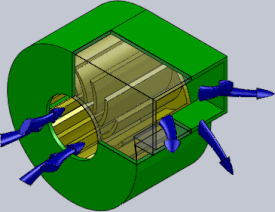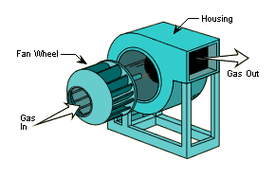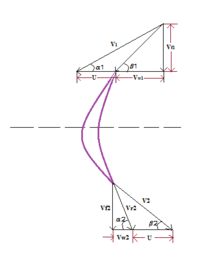Howdy friends, today I will give you the best product reviews are Centrifugal fan blower squirrel cage fan . You can read some of the features of products Centrifugal fan blower squirrel cage fan below:
Centrifugal fan blower squirrel cage fan FEATURE
Centrifugal fan
A centrifugal fan is a mechanical device for moving air or other gases. The terms "blower" and "squirrel cage fan" (because it looks like a hamster wheel) are frequently used as synonyms. These fans increase the speed of air stream with the rotatingimpellers.[1]
They use the kinetic energy of the impellers or the rotating blade to increase the pressure of the air/gas stream which in turn moves them against the resistance caused by ducts, dampers and other components. Centrifugal fans accelerate air radially, changing the direction (typically by 90°) of the airflow. They are sturdy, quiet, reliable, and capable of operating over a wide range of conditions.[2]
Centrifugal fans are constant displacement devices or constant volume devices, meaning that, at a constant fan speed, a centrifugal fan will pump a constant volume of air rather than a constant mass. This means that the air velocity in a system is fixed even though mass flow rate through the fan is not.[citation needed]
Centrifugal fans are not positive displacement devices. Centrifugal fans have certain advantages and disadvantages when contrasted with positive-displacement blowers.[3][4][5][6][7]
The centrifugal fan is one of the most widely used fans. Centrifugal fans are by far the most prevalent type of fan used in theHVAC industry today. They are usually cheaper than axial fans and simpler in construction.[8] It is used in transporting gas or materials and in ventilation system for buildings.[9] They are also used commonly in central heating/cooling systems. They are also well-suited for industrial processes and air pollution control systems.
It has a fan wheel composed of a number of fan blades, or ribs, mounted around a hub. As shown in the animated figure, the hub turns on a driveshaft that passes through the fan housing. The gas enters from the side of the fan wheel, turns 90 degrees and accelerates due to centrifugal force as it flows over the fan blades and exits the fan housing.[10]
Contents
[hide]History[edit]
The centrifugal fan was invented by Russian military engineer Alexander Sablukov in 1832, and found its usage both in the Russian light industry (such as sugar making) and abroad.[11]
Construction[edit]
Main parts of a centrifugal fan are :
- Fan housing
- Impellers
- Inlet and outlet ducts
- Drive shaft
- Drive mechanism
Other components used may include bearings, couplings, impeller locking device, fan discharge casing, shaft seal plates etc.[12]
Drive mechanisms[edit]
The fan drive determines the speed of the fan wheel (impeller) and the extent to which this speed can be varied. There are three basic types of fan drives.[10]
Direct[edit]
The fan wheel can be linked directly to the shaft of an electric motor. This means that the fan wheel speed is identical to the motor's rotational speed. With this type of fan drive mechanism, the fan speed cannot be varied unless the motor speed is adjustable. Air conditioning will then automatically provide faster speed because colder air is more dense.
Some electronics manufacturers have made centrifugal fans with external rotor motors (the stator is inside the rotor), and the rotor is directly mounted on the fan wheel (impeller).
Belt[edit]
A set of sheaves is mounted on the motor shaft and the fan wheel shaft, and a belt transmits the mechanical energy from the motor to the fan.
The fan wheel speed depends upon the ratio of the diameter of the motor sheave to the diameter of the fan wheel sheave and can be obtained from this equation:[10]
Chain drive fans are not common due to their complex workup, high maintenance, noisiness, and speed and flexibility limitations which prevents them from being operated at high speeds, but they are much more durable, require less operating space, have a cheaper initial and installation cost, don't slip, and are resistant towards many hostile environments. They can be just as efficient as belt drive, however, both will require tensioning.

| where: | |
 | = fan wheel speed, revolutions per minute |
|---|---|
 | = motor nameplate speed, revolutions per minute |
 | = diameter of the motor sheave |
 | = diameter of the fan wheel sheave |
Fan wheel speeds in belt-driven fans are fixed unless the belt(s) slip. Belt slippage can reduce the fan wheel speed by several hundred revolutions per minute (rpm).
Variable[edit]
Variable drive fans may use hydraulic or magnetic couplings (between the fan wheel shaft and the motor shaft) that allow variable speed. The fan speed controls are often integrated into automated systems to maintain the desired fan wheel speed.[10]
An alternate method of varying the fan speed is by use of an electronic variable-speed drive which controls the speed of the motor driving the fan. This offers better overall energy efficiency than mechanical couplings, especially at greatly-reduced speeds.
Bearings[edit]
Bearings are an important part of a fan. Sleeve-ring oil bearings are used extensively in fans. Some sleeve-ring bearings may be water-cooled. Water-cooled sleeve bearings are often used when hot gases are being moved by the fan. Heat is conducted through the shaft and into the oil which must be cooled to prevent overheating of the bearing.
Since lower-speed fans have bearings in hard-to-reach spots, grease-packed anti-friction bearings are used.
Fan dampers and vanes[edit]
Fan dampers are used to control gas flow into and out of the centrifugal fan. They may be installed on the inlet side or on the outlet side of the fan, or both. Dampers on the outlet side impose a flow resistance that is used to control gas flow. Dampers on the inlet side (inlet vanes) are designed to control gas flow by changing the amount of gas or air admitted to the fan inlet.
Inlet dampers (inlet vanes) reduce fan energy usage due to their ability to affect the airflow pattern into the fan.[10]
Fan blades[edit]
The fan wheel consists of a hub on which a number of fan blades are attached. The fan blades on the hub can be arranged in three different ways: forward-curved, backward-curved or radial.[10]
Forward-curved[edit]
Forward-curved blades, as in Figure 3(a), curve in the direction of the fan wheel's rotation. These are especially sensitive to particulates.[clarification needed] Forward-curved blades provide a low noise level and relatively small air flow with a high increase in static pressure. [14]
Backward-curved[edit]
Backward-curved blades, as in Figure 3(b), curve against the direction of the fan wheel's rotation. Smaller blowers may have backward-inclined blades, which are straight, not curved. Larger backward-inclined/-curved blowers have blades whose backward curvatures mimic that of an airfoil cross section, but both designs provide good operating efficiency with relatively economical construction techniques. These types of blowers are designed to handle gas streams with low to moderate particulate loadings[citation needed]. They can be easily fitted with wear protection but certain blade curvatures can be prone to solids build-up.[citation needed]. Backward curved wheels are often lighter than corresponding forward-curved equivalents, as they don't require so many blades.
Backward curved fans can have a high range of specific speeds but are most often used for medium specific speed applications—high pressure, medium flow applications.[citation needed]
Backward-curved fans are much more energy efficient than radial blade fans and so, for high power applications may be a suitable alternative to the lower cost radial bladed fan.[citation needed]
Straight radial[edit]
Radial blowers, as in Figure 3(c), have wheels whose blades extend straight out from the center of the hub. Radial bladed wheels are often used on particulate-laden gas streams because they are the least sensitive to solid build-up on the blades, but they are often characterized by greater noise output. High speeds, low volumes, and high pressures are common with radial blowers[citation needed], and are often used in vacuum cleaners, pneumatic material conveying systems, and similar processes.
Principles of operation[edit]
The centrifugal fan uses the centrifugal power supplied from the rotation of impellers to increase the kinetic energy of air/gases. When the impellers rotate, the gas particles near the impellers are thrown-off from the impellers, then moves into the fan casing. As a result, the kinetic energy of gas is measured as pressure because of the system resistance offered by the casing and duct. The gas is then guided to the exit via outlet ducts. After the gas is thrown-off, the gas pressure in the middle region of the impellers decreases. The gas from the impeller eye rushes in to normalize this This cycle repeats and therefore the gas can be continuously transferred.
| Differences between fans and blowers | ||
| Equipment | Pressure Ratio | Pressure rise (mm H2O) |
|---|---|---|
| Fans | Up to 1.1 | 1136 |
| Blowers | 1.1 to 1.2 | 1136-2066 |
Velocity triangle[edit]
Main article: Velocity triangle
An diagram called a velocity triangle helps us in determining the flow geometry at the entry and exit of a blade. A minimum number of data are required to draw a velocity triangle at a point on blade. Some component of velocity varies at different point on the blade due to changes in the direction of flow. Hence an infinite number of velocity triangles are possible for a given blade. In order to describe the flow using only two velocity triangles we define mean values of velocity and their direction. Velocity triangle of any turbo machine has three components as shown:
- U Blade velocity
- Vr Relative Velocity
- V Absolute velocity
These velocities are related by the triangle law of vector addition:
This relatively simple equation is used frequently while drawing the velocity diagram. The velocity diagram for the forward, backward face blades shown are drawn using this law. The angle α is the angle made by the absolute velocity with the axial direction and angle β is the angle made by blade with respect to axial direction.
Difference between fans and blowers[edit]
The property that distinguishes a centrifugal fan from a blower is the pressure ratio it can achieve. In general, a blower can produce a higher pressure ratio. As per American Society of Mechanical Engineers (ASME) the specific ratio - the ratio of the discharge pressure over the suction pressure – is used for defining the fans and blowers (Table 1).[citation needed]
Ratings[edit]
Ratings found in centrifugal fan performance tables and curves are based on standard air SCFM. Fan manufacturers define standard air as clean, dry air with a density of 0.075 pounds mass per cubic foot (1.2 kg/m³), with the barometric pressure at sea level of 29.92 inches of mercury (101.325 kPa) and a temperature of 70 °F (21 °C). Selecting a centrifugal fan to operate at conditions other than standard air requires adjustment to both static pressure and power.
At higher-than-standard elevation (sea level) and higher-than-standard temperature, air density is lower than standard density. Air density corrections need to be taken into account for centrifugal fans that are specified for continuous operation at higher temperatures. The centrifugal fan will displace a constant volume of air in a given system regardless of the air density.
When a centrifugal fan is specified for a given CFM and static pressure at conditions other than standard, an air density correction factor must be applied to select the proper size fan to meet the new condition. Since 200 °F (93 °C) air weighs only 80% of 70 °F (21 °C) air, the centrifugal fan will create less pressure and require less power. To get the actual pressure required at 200 °F (93 °C), the designer would have to multiply the pressure at standard conditions by an air density correction factor of 1.25 (i.e., 1.0/0.8) to get the system to operate correctly. To get the actual power at 200 °F (93 °C), the designer would have to divide the power at standard conditions by the air density correction factor.
Air Movement and Control Association (AMCA)[edit]
The centrifugal fan performance tables provide the fan RPM and power requirements for the given CFM and static pressure at standard air density. When the centrifugal fan performance is not at standard conditions, the performance must be converted to standard conditions before entering the performance tables. Centrifugal fans rated by theAir Movement and Control Association (AMCA) are tested in laboratories with test setups that simulate installations that are typical for that type of fan. Usually they are tested and rated as one of four standard installation types as designated in AMCA Standard 210.[15]
AMCA Standard 210 defines uniform methods for conducting laboratory tests on housed fans to determine airflow rate, pressure, power and efficiency, at a given speed of rotation. The purpose of AMCA Standard 210 is to define exact procedures and conditions of fan testing so that ratings provided by various manufacturers are on the same basis and may be compared. For this reason, fans must be rated in standardized SCFM.
Losses[edit]
| This section does not cite any references or sources. (April 2015) |
Centrifugal fans suffer efficiency losses in both stationary and moving parts, increasing the energy input required for a given level of airflow performance.
Impeller entry[edit]
Flow at the intake and its turning from axial to radial direction causes losses at the intake. Friction and flow separation cause impeller blade losses since there is change in incidence angle.[further explanation needed] These impeller blade losses are also included in the category.
Leakage[edit]
Leakage of some air and disturbance in the main flow field is caused due to the clearance provided between the rotating periphery of the impeller and the casing at the entry.
Impeller[edit]
Passage friction and flow separation causes impeller losses which are dependent on relative velocity, rate of diffusion and blade geometry. Impeller dynamic balancing usually is done on a precision balancing machine, because all energy of vibrational imbalance is lost (for example, this can easily amount to 50% of air-flow loss in poorly-maintained home AC units).[citation needed]
Diffuser and volute[edit]
Friction and flow separation also causes losses in the diffuser. Further losses due to incidence occur if the device is working beyond its design conditions. Flow from the impeller or diffuser expands in the volute, which has a larger cross section leading to the formation of eddy, which in turn reduces pressure head. Friction and flow separation losses also occur due the volute passage.
Disc friction[edit]
Viscous drag on the back surface of the impeller disc causes disc friction losses.
See also[edit]
| Wikimedia Commons has media related to Centrifugal fans. |
Thank you've read product reviews Centrifugal fan blower squirrel cage fan. If you want to look for reviews of products other power hand tools. Please type in a keyword in the search field above products that we have provided in this blog. And do not forget if our product review article useful please share Centrifugal fan blower squirrel cage fan to friends, relatives, your family. Share button on the social media we have provided below.
Judul: Centrifugal fan blower squirrel cage fan
Rating: 100% based on 99998 ratings. 5 user reviews.
Ditulis Oleh 23:48
Rating: 100% based on 99998 ratings. 5 user reviews.
Ditulis Oleh 23:48








0 comments:
Post a Comment